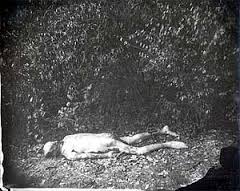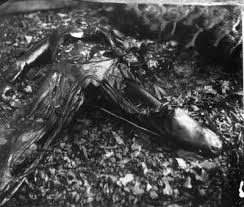The second stage of decomposition, Algor Mortis translates to “coldness” [algor] “of death” [mortis]. Algor Mortis, sometimes refered to as the “death chill”, is marked by a steady decline in body temperature and continues until the corpse reaches “ambient temperature”, or matches the temperature of its surroundings. Algor Mortis usually sets in one hour after death, but many factors have significant influence on this phase of decomposition. Determining the correct time of death by way of body temperature can be difficult due to stability/fluctuation of ambient temperature, the thermal conductivity of the surface the corpse is on and what is known as a “temperature plateau”, a highly variable period of time in which the body does not cool. The rate of cooling may be increased if the deceased is thin or malnourished or if the body is exposed to low temperatures and/or a windy environment. On the other hand, if the person was febrile (running a fever), under the influence, obese or left in a warm environment, the rate of cooling will decrease. Clothing can also play a major role in speeding up or slowing down Algor Mortis. The corpse will cool faster if large amounts of skin are exposed or when wearing wet clothing. Dry, layered, heavy clothing keeps the body warm for a longer period of time after death. Once the body begins true decomposition, the temperature will rise again, making Algor Mortis most helpful in determining time of death within the first 24 hours. Temperature readings can be obtained from the rectum of the deceased or by inserting a meat thermometer under the ribcage on the right side of the corpse and into the liver. Investigators use the Glaister Equation to estimate the time of death. While the temperature change can vary anywhere between a 1 degree Fahrenheit drop in temperature per hour to a 12 degree F drop per hour, the average is 1.5 degree F drop per hour, each hour following death. The Glaister Equation uses 98.4 degrees F (average body temperature) minus the rectal (or internal) temperature in degrees F, divided by 1.5 degrees F, to equate time of death. During this stage of decomposition, we also usually begin to see full corneal cloudiness in eyes which remained open after death.
Check out the NEW BOOK by The Post-Mortem Post’s Head Writer ‘Horrible History: Mass Suicides’ AVAILABLE NOW on Amazon Kindle!
Read about Stage 1: Pallor Mortis and Stage 3: Rigor Mortis
If you enjoyed this article, you may also like Everybody Poops: The Post-Mortem Edition and Demystifying the Process of Dying
Follow us on Twitter @PostMortem_post





